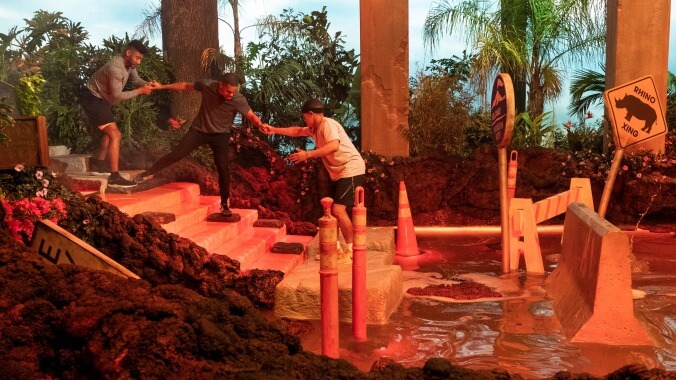Floor Is Lava is a live-action video game, and that’s awesome

Every Friday, A.V. Club staffers kick off our weekly open thread for the discussion of gaming plans and recent gaming glories, but of course, the real action is down in the comments, where we invite you to answer our eternal question: What Are You Playing This Weekend?
There’s a John Mulaney bit where he talks about quicksand, and the gulf between how often childhood cartoons primed him to have to deal with it in his adult life, versus how often the topic ever actually comes up. The same could just as easily be said—maybe even more so—for the relationship between video games and lava. From Super Mario Bros. to Minecraft and beyond, lava has been a consistent video game MVP (magma valuable player, natch) for decades, and for completely understandable reasons: It’s bright, it’s beautiful, and it kills you pretty much the second you touch it. It’s essentially the perfect video game material.
That shared respect for the pyroclastic flow helps explain why Netflix’s new game show, Floor Is Lava, comes closer to replicating the feel of a live-action video game than pretty much any such show in recent memory. Even when compared to other “No, really this is a video game!” game shows—old standby Nick Arcade, or Syfy’s 2008 hide-and-seek competition Chase—Floor Is Lava feels informed by the logic (or lack thereof) of classic video game design, from the improbable leaps, to the big cartoon keys hidden in pizza ovens, to the ever-bubbling presence of the bright orange lake of lava its contestants are constantly forced to traverse.
Sure, the obvious inspiration for the show’s design—which sees players crossing various themed rooms, including “The Kitchen,” “The Basement,” and that old suburban home standby, “The Planetarium”—is the classic furniture-parkour game most of us played as kids, the bane of moms and glass-topped coffee tables worldwide. But childhood games of “floor is lava” don’t have actual game designers on hand, crafting alternate routes, specific challenges, and other obstacles for their players to traverse. That sense of authorship—or, in gaming parlance, level design—is part of what makes Floor Is Lava so fascinating to watch. Whereas other obstacle course-based game shows—most notably the far more grueling American Ninja Warrior franchise—send players on a linear path across monkey bars from hell, Floor Is Lava takes a page from the old Sid Meier line, and turns the competition into “a series of interesting choices.” Do you swing across the kitchen on the giant mozzarella? Is it smarter to go for the slippery rocks or the rotating bed? Do those bar stools swivel when you jump on them? (Yes. Prepare to eat shit.) These are the same considerations any level designer has to think about when designing a world for players to run through; the fact that it’s happening on some fluid-splattered soundstage, rather than a computer, hardly matters at all.
And below it all burbles the lava, a tantalizing, apparently very slippery muse. (According to this Vulture interview with show creators Irad Eyal and Megan McGrath, it’s a “proprietary mix” whipped up in one of “Hollywood’s foremost slime manufacturing labs.” Also, they refuse to answer what happens after contestants melodramatically “sink” into the lava when they fall in, though they did assure young viewers that the contestants do not die, which is nice.) The lava is both obstacle and visual draw, steadily making the “level” harder to navigate with every friction-reducing blast, while also giving the whole show its eye-blistering neon style. But for as invitingly bubbly as said magma might be, there’s an even bigger lure at play here: the joy of watching people work out weird problems in real time. The show’s relatively light set of rules—which include a note stating that any object in the room is in play and fair game for traversal—allows for fascinating moments of decision-making, teamwork, and, occasionally, triumph. The show’s free-form approach allows for a whole bunch of what we video game nerds refer to as “expressive play,” where a game’s narrative is penned, not by the designer, but by the choices of the person playing it. Floor Is Lava captures the drama of those agonizing choices extraordinarily well, and proves that the show’s commitment to some of the same principles that make digital gaming so great is far more than just scoria-deep.